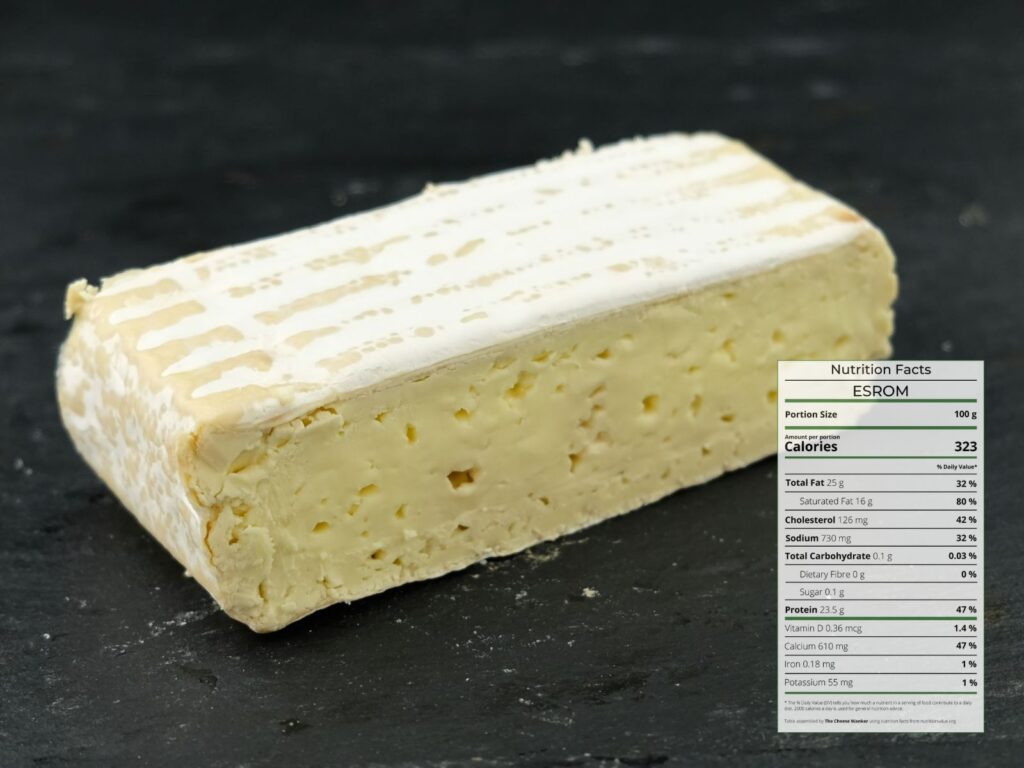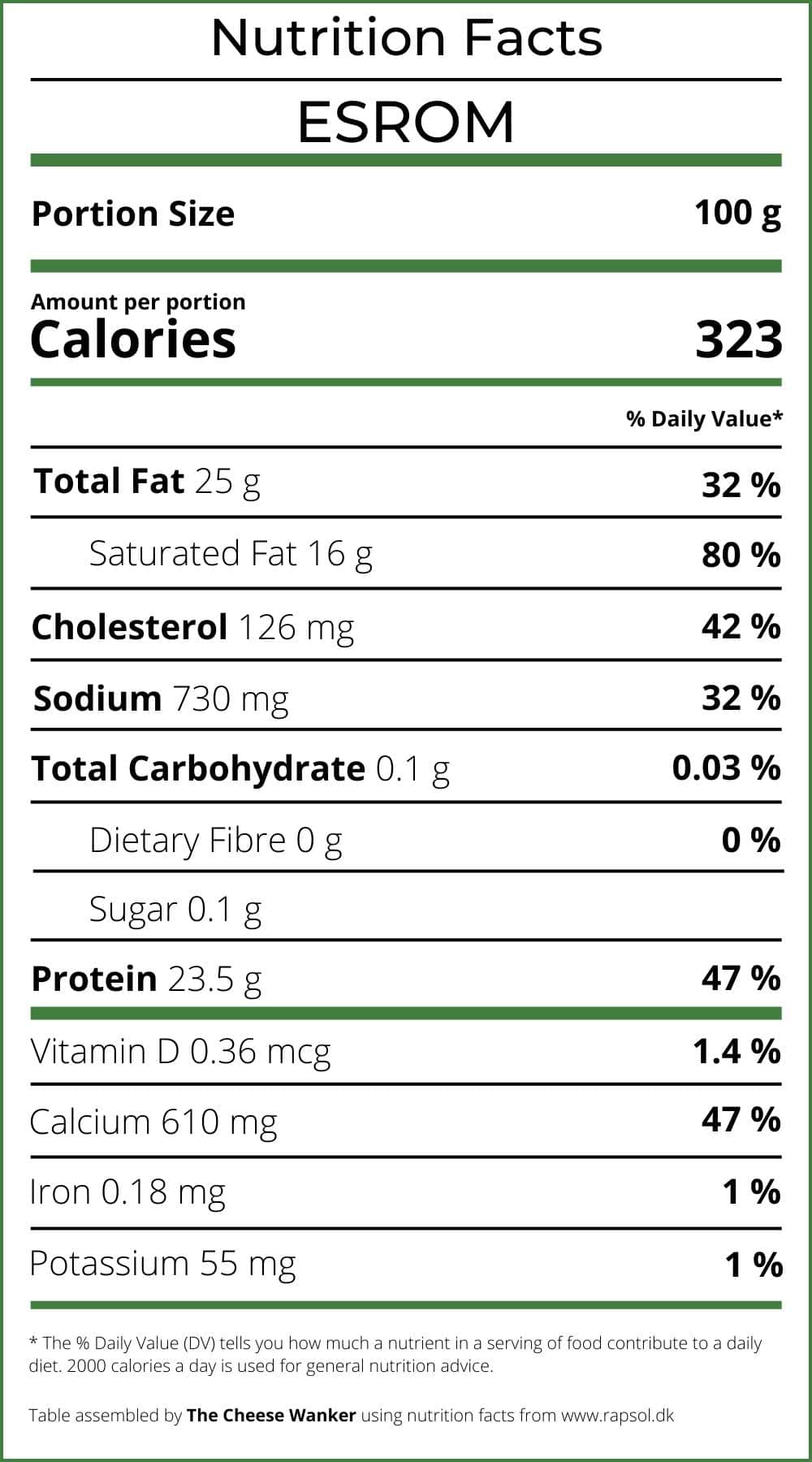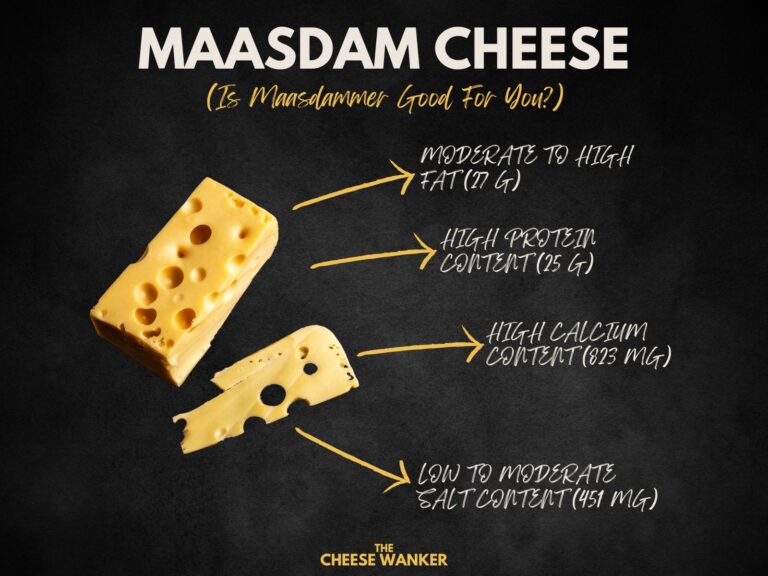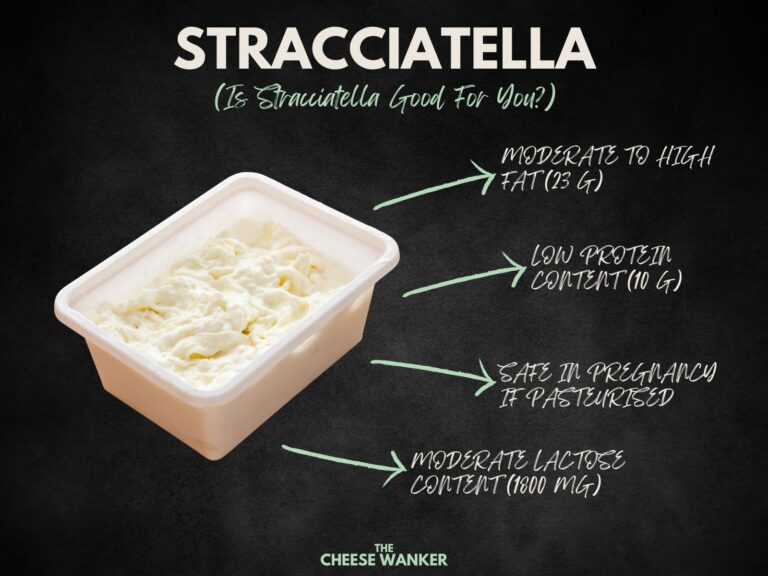Esrom cheese is a semi-soft, Danish cheese made from cow’s milk. It has a creamy texture, a pungent aroma, and a sweet and tangy taste. In fact, this IGP cheese bears a striking resemblance to some other European washed rind cheeses Taleggio and Port Salut. Read on to discover the nutrition facts for Esrom.

SEE ALSO: Nutrition facts for popular world cheeses in The Cheese Wanker’s index →

Nutrition Facts Summary for Esrom
This classic Danish cheese is a popular addition to sandwiches and can also be served as a table cheese. Let’s have a look at some of its more important nutrition facts.
Lactose Intolerance
As a matter of fact, Esrom contains little to no lactose. Indeed, lab testing has revealed a lactose content below 0.1 g per 100 g of cheese. As a result, even the most sensitive lactose intolerant cheese lovers should be able to digest this washed rind cheese.
Find out everything you’ve ever wanted to know about lactose free cheeses by clicking here.
Fat Content
Esrom cheese has a relatively high fat content, with around 25 g per 100 g. Coupled with its low carbohydrate content, the fat in Esrom makes it a great option for people following a keto diet. However, people who are wanting to restrict their fat intake should consume this cheese in moderation.
Moreover, it is a good option for people following a ketogenic diet. You can learn more about the keto diet and which cheeses are most keto-friendly by clicking here.
Protein Content
Like most cheeses, Esrom is a great source of protein, with around 23 g per 100 g. Protein is an essential nutrient that is important for building and repairing tissues, maintaining muscle mass, and supporting immune function. Consuming this cheese as part of a balanced diet can help meet daily protein needs.
Want to find out which cheeses have the highest protein content? Click here for our blog post covering this topic.
Safety in Pregnancy
Pregnant women are advised to avoid consuming soft cheeses made from raw milk due to the risk of Listeria infection. Even though most versions of Esrom are made with pasteurised milk, health authorities advise against eating this cheese if you’re pregnant. The reason for this is its rind.
Having said that, you can definitely cook this Danish cheese into a delicious dish such as a Grilled Cheese Sandwich or a Mushroom Melt.
You can read more about which cheeses are safe to eat when you’re pregnant by clicking here. As always, if unsure, you should consult your doctor.
Salt Content
Esrom cheese is relatively high in salt, with around 730 mg of sodium per 100 g of cheese. Consuming too much salt can lead to high blood pressure, which increases the risk of heart disease and stroke.
Therefore, it is important to consume this cheese in moderation and balance it with other low-salt foods.
Conclusion
Without a doubt, Esrom is a tasty and nutritious cheese that can be enjoyed as part of a healthy diet. However, it is important to be aware of its fat and salt content, especially if you have dietary restrictions or health concerns.
By consuming this cheese in moderation, you can enjoy its delicious taste and reap its nutritional benefits.
References
Overall nutritional content
The nutritional content of cheese in our table comes from the USDA Food Data Central Repository, the Australian Food Composition Database and cheese manufacturers. We realise that there can be variations between different brands and producers. Hence, the numbers we have used are averages.
Fat content
Our fat RDI data comes from Cleveland Clinic’s Healthy Fat Intake resource.
Type of fat in cheese as per Harvard T.H. Chan’s The Nutrition Source.
Protein content
Our protein RDI data comes from Harvard Medical School’s Harvard Health Publishing.
Cholesterol content
Is There a Correlation between Dietary and Blood Cholesterol? Evidence from Epidemiological Data and Clinical Interventions? – Maria Luz Fernandez and Ana Gabriela Murillo
Saturated fat, carbohydrate, and cardiovascular disease – Patty W Siri-Tarino, Qi Sun, Frank B Hu and Ronald M Krauss
Effect of cheese consumption on blood lipids: a systematic review and meta-analysis of randomized controlled trials – Janette de Goede, Johanna M Geleijnse, Eric L Ding, Sabita S Soedamah-Muthu
Safety in pregnancy
All the advice relating to what cheeses you can eat during pregnancy in this article is based on the recommendations by health authorities in Australia, the UK and the USA. If you are unsure about what you can or cannot eat, please consult your doctor.
Australia – FSANZ, United Kingdom – NHS and United Sates of America – FDA
Lactose content
Lactose residual content in PDO cheeses
Detection of lactose in products with low lactose content
The analysis of lactose in milk and cheese products by HPLC
Food Standards ANZ Food Composition Database
Lactose & Galactose content of cheese



